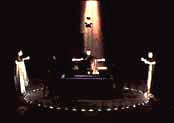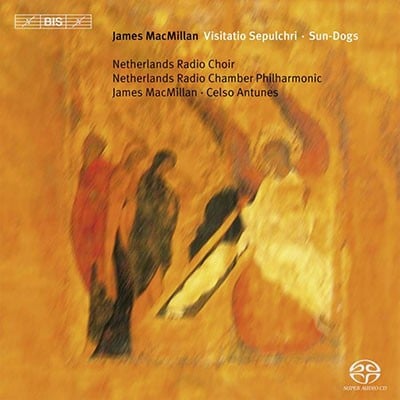OPERA SEARCH

Visitatio Sepulchri
(1992-93)Texts from a 14th century Easter Day liturgical drama and the Te Deum (L)
2S,A,2T,B,male speaker (Sprechstimme)
2(II=picc).2(II=corA).2(II=bcl).2(II=dbn)-2.2.2(II=btrbn).0-timp.
perc(1):2cowbells/2wdbl/2bongos/2timbales/SD/2tam-t/5tom-t/
5tpl.bl/glsp/t.bells/BD/cyms/bell tree-strings(min:8.6.4.4.2)
NB: this work is available both as a music theatre piece and for
concert performance
Abbreviations (PDF)
Boosey & Hawkes
Tramway, Glasgow
Francisco Negrin, Regisseur
Conductor: Ivor Bolton
Company: Scottish Chamber Orchestra
| ERSTE FRAU | Sopran |
| ZWEITE FRAU | Sopran |
| DRITTE FRAU | Alt |
| ERSTER ENGEL | Tenor |
| ZWEITER ENGEL | Tenor |
| DRITTER ENGEL | Baß |
| KANTOR | Männlicher Sprecher |
In der Eröffnungsszene reflektiert das Orchester ohne Text die Ereignisse vom Karfreitag: die Gewalt der Kreuzigung und die Qualen und den Todesschmerz auf Golgatha. Die zweite Szene spielt am Ostermorgen, als drei Frauen das geöffnete, leere Grab Jesu finden. Am Eingang zu dem Grab begegnen die Frauen drei Engeln. "Wen sucht ihr?" erkundigen sich die Engel, und die Frauen antworten: "Jesus von Nazareth." "Er ist nicht hier, er ist von den Toten auferstanden, wie es vorausgesagt wurde. Geht und sagt es der Welt." Während sich der karge, rituelle Dialog entfaltet, wird die Geschichte der Auferstehung bereits zum ersten Mal weitergegeben. Der Kantor spricht für das Publikum; die Fragen, die er zwischendurch stellt, seine Kommentare und Ausrufe klingen wie von der zuschauenden Menge: "Ist es wahr? Maria ist glaubwürdiger als das verlogene Volk."
Die letzte Szene geht von der persönlichen Offenbarung der drei Frauen zum Gebet der Gemeinde über, wie es im Lauf der Jahrhunderte in der Liturgie rituelle Form gefunden hat. Die Charaktere vereinen sich in einer dramatischen Fassung des Te Deum (Wir preisen dich, Gott), womit die Ostergeschichte und die Feier der Auferstehung ihren Höhepunkt erreichen. Nach der Tutti-Eröffnung tauchen im Mittelabschnitt wieder menschliche Individuen auf, die Christus anrufen, sein Volk zu befreien und zu retten. Das Drama endet mit einer letzten Anrufung Gottes um Barmherzigkeit, Hoffnung und Schutz, zunächst mit leidenschaftlichen Blechbläserhymnen, dann in die Ferne verschwindend wie Gebete.
Choral level of difficulty: Level 5 (5 greatest)
This work is one of a number by MacMillan that can be presented in a number of formats: fully staged as at its premiere, in a music theatre style with simple lighting, or as a purely concert work. Orginally performed with solo voices, MacMillan recast the work for seven-part choir, each choral section taking one of the solo parts. Visitation Sepulchri dates from the time the composer first burst onto the musical scene with works such as The Confession of Isobel Gowdie and Veni, Veni, Emmanuel, and shares their blending of energy, passion and reflection.
In biblical terms it moves on from where his St John Passion ends as it is concerned with the women’s visit to the sepulchre where Jesus’ body has been laid following his crucifixion. Scene One is a purely orchestral, powerfully moving scene-setter mirroring the drama of the crucifixion. Scene Two introduces three angels (TTB), the three women (SSA) and a male Cantor section which sings/speaks/shouts un-notated, approximate pitch throughout (rather like sprechstimme). The extreme contrasts between the still, reflective meditations of the singers and the dramatic brass-dominated interjections from the orchestra seem to reflect an outward prayerfulness and inward turbulence following the Angels’ confirmation of Jesus’ resurrection. Scene Three follows without a break and is a setting of the Te Deum. This is complex and incredibly energised. The winding-down process sees a statement of the plainsong Te Deum melody used effectively in long notes against a still hyperactive orchestra. At the end of the text, ‘let me never be confounded’, the music moves into an extraordinarily different mode – almost cinematic in its triumph and consolation which might follow the successful resolution of the plot of a thriller. The voices whisper a fade-out.
This remarkable score is complex and needs highly skilled singers with, in some cases, fairly extreme ranges: the 1st tenors have to touch a top D flat at one point and the 3rd Angel (basses) begins the second scene on low Es. The orchestral writing is often virtuoso and the whole work will, of course, need to generate theatrical electricity whether performed staged or in concert. MacMillan’s deep feeling for religious drama is one of the things which sets him apart from almost all his composer colleagues working at this level.
Repertoire note by Paul Spicer
poetisch

Netherlands Radio Choir / Netherlands Radio Chamber Philharmonic / James MacMillan
BIS SACD 1719

